
The Royal Netherlands Navy is the naval force of the Kingdom of the Netherlands.

HMS Quilliam (G09) was a Q-class destroyer serving in the Royal Navy from 1942 to 1945. She was then transferred to the Royal Netherlands Navy, where she was commissioned as HNLMS Banckert (D801) from until 1957.
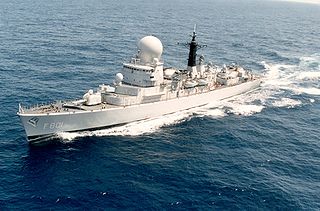
The Tromp class were two frigates built for the Royal Netherlands Navy during the 1970s to replace the De Zeven Provinciën-class cruisers as squadron flagships.

The Holland-class destroyers were built for the Royal Netherlands Navy in the 1950s. They were the first major warships designed and built by the Dutch after World War II. In contrast to previous Dutch Navy practice the ships were named after provinces rather than admirals.
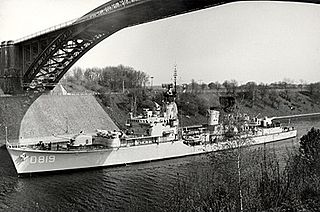
The Friesland-class destroyers were built for the Royal Netherlands Navy in the 1950s. They were a larger modified version of the Holland class with more powerful machinery. Eight ships were built. They were replaced by the Kortenaer-class frigates in the early 1980s and seven ships were sold to the Peruvian Navy where they served until 1991. The main armament was supplied by Bofors.
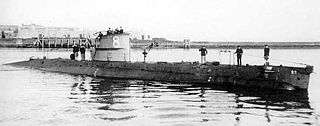
HMS H6 was a British H-class submarine of the Royal Navy built by Canadian Vickers & Co. during World War I.

The A class were four minesweepers of the Royal Netherlands Navy. They were the first purpose-built minesweepers of the Dutch Navy, as earlier minesweepers were converted tugboats.

HNLMS Douwe Aukes was a minelayer of the Royal Netherlands Navy. She was built in the Gusto shipyard at Schiedam as the lead ship of the Douwe Aukes class, and one of her early commanders was Eugène Lacomblé.

SM UC-8 was a German Type UC I minelayer submarine or U-boat in the German Imperial Navy during World War I. The U-boat had been ordered by November 1914 and was launched on 6 July 1915. She was commissioned into the German Imperial Navy on 5 July 1915 as SM UC-8. Mines laid by UC-8 in her one patrol are not known to have sunk any ships. UC-8 ran aground on the Dutch coast near Terschelling on 4 November 1915. Interned by the Dutch, UC-8 was purchased and commissioned into the Dutch Navy as HNLMS M-1. The submarine was broken up in 1932.

HNLMS Van Meerlant was a minelayer of the Royal Netherlands Navy built in the Gusto shipyard at Schiedam as part of the Douwe Aukes class.

HNLMS Medusa was a Dutch Hydra-class minelayer, built in Amsterdam and named after Medusa in Greek mythology.
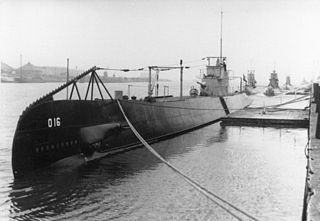
HNLMS O 16 was a submarine of the Royal Netherlands Navy that saw service during World War II. She was the first submarine of the RNN manufactured from high-quality Steel 52, with the ability to dive at a depth of 80 metres (260 ft).
Damen Naval is a Dutch shipyard, and a continuation of the Koninklijke Maatschappij De Schelde, responsible for a number of ships used by the Royal Netherlands Navy. It is owned by the Damen Group. Damen Naval is situated in Vlissingen.

O 10 was a O 9-class patrol submarines of the Royal Netherlands Navy. The ship was built by Nederlandsche Scheepsbouw Maatschappij shipyard in Amsterdam.
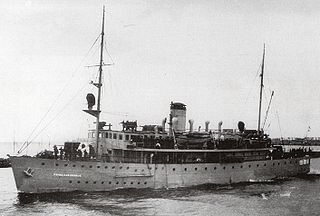
HNLMS Prins van Oranje was a Prins van Oranje-class minelayer of the Royal Netherlands Navy build by N.V. Internationale Scheepsbouw Mij. 'De Maas'. She was designed for service in the Dutch East Indies. She was sunk during World War II by Japanese forces.

HNLMS Gouden Leeuw was a Prins van Oranje-class minelayer of the Royal Netherlands Navy built by N.V. Internationale Scheepsbouw Mij. 'De Maas'. She was designed for service in the Dutch East Indies. She was scuttled during World War II by her own crew.
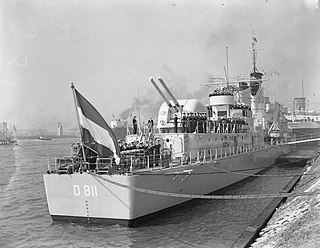
HNLMS Gelderland (D811) was a destroyer of the Holland class. The ship was in service with the Royal Netherlands Navy from 1955 to 1973. The destroyer was named after the Dutch province of Gelderland and was the twenty-first ship with this name. In 1973 the ship was taken out of service, after which it was given a berth in Amsterdam for the Technical Training Royal Navy (TOKM) school. During her service the ship's radio call sign was "PARY". The ship was sold for scrapping in 1988.

HNLMS Van Galen (F834) is a ship of the Karel Doorman class of multi-purpose frigates of the Royal Netherlands Navy. Built by the shipyard Koninklijke Schelde Groep in Vlissingen. The ship is named after captain and convoy commander Johan van Galen and served from 1994 to 2008 with the Dutch navy. The radio call sign of the frigate was "PAMG".

The K-class torpedo boats were a class of three small warships that served in the Dutch Koninklijke Marine. The K stands for 'Klein', as these ships were ordered next to the larger G 1-class torpedo boat, where the G stands for 'Groot'. The 48-ton ships were ordered in 1904 and commissioned the next year. Christiaan Cornelis saw limited action at the start of World War II during the Battle of the Netherlands in 1940.

The Z-class torpedo boats were a class of twelve warships that served in the Dutch Koninklijke Marine, German Kaiserliche Marine, Polish Marynarka Wojenna and British Royal Navy. The Royal Netherlands Navy ordered eight Z-class torpedo boats before the outbreak of World War I, four were to be built by the German shipbuilder AG Vulcan Stettin, to be named Z 1 to Z 4, while four others were to be built in the Netherlands; Z 5 to Z 8. After the outbreak of World War I the four ships under construction in Germany where requisitioned for service in the German navy, resulting in the Dutch Navy to order another four ships to be built in the Netherlands. The ships saw action during both World War I and World War II. One of the German ships was lost in World War I, while one Polish and one Dutch ship sank during World War II. Another Polish torpedo boat sank in peacetime due to a boiler explosion.



















